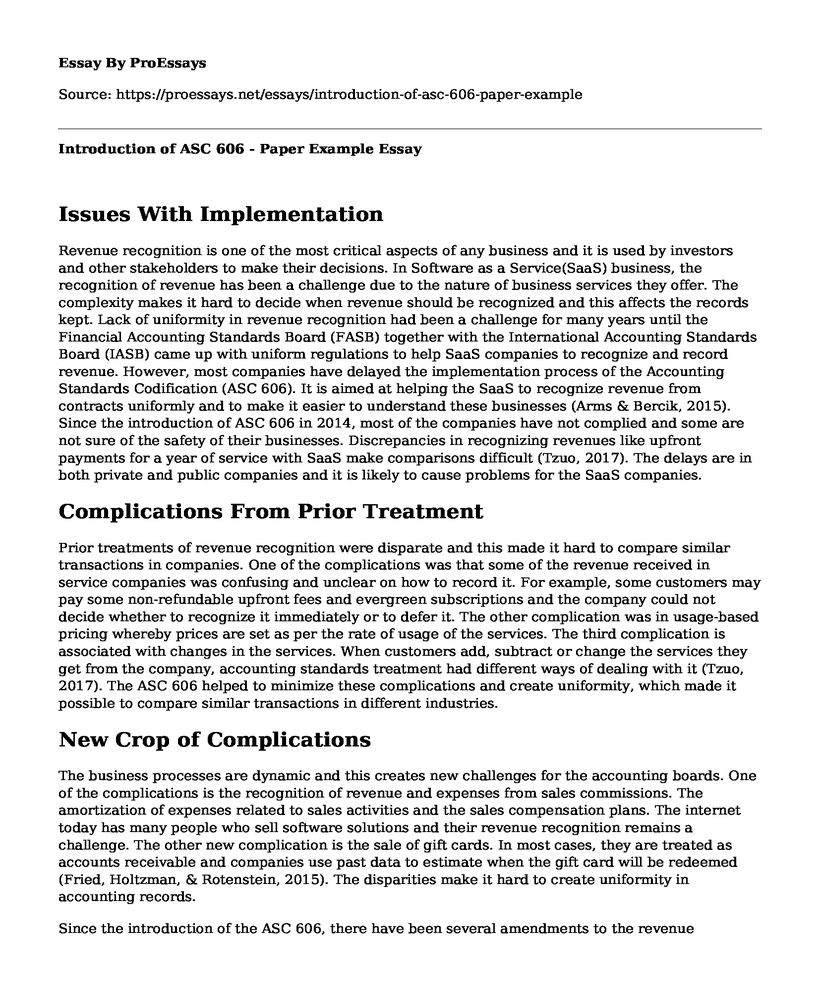Issues With Implementation
Revenue recognition is one of the most critical aspects of any business and it is used by investors and other stakeholders to make their decisions. In Software as a Service(SaaS) business, the recognition of revenue has been a challenge due to the nature of business services they offer. The complexity makes it hard to decide when revenue should be recognized and this affects the records kept. Lack of uniformity in revenue recognition had been a challenge for many years until the Financial Accounting Standards Board (FASB) together with the International Accounting Standards Board (IASB) came up with uniform regulations to help SaaS companies to recognize and record revenue. However, most companies have delayed the implementation process of the Accounting Standards Codification (ASC 606). It is aimed at helping the SaaS to recognize revenue from contracts uniformly and to make it easier to understand these businesses (Arms & Bercik, 2015). Since the introduction of ASC 606 in 2014, most of the companies have not complied and some are not sure of the safety of their businesses. Discrepancies in recognizing revenues like upfront payments for a year of service with SaaS make comparisons difficult (Tzuo, 2017). The delays are in both private and public companies and it is likely to cause problems for the SaaS companies.
Complications From Prior Treatment
Prior treatments of revenue recognition were disparate and this made it hard to compare similar transactions in companies. One of the complications was that some of the revenue received in service companies was confusing and unclear on how to record it. For example, some customers may pay some non-refundable upfront fees and evergreen subscriptions and the company could not decide whether to recognize it immediately or to defer it. The other complication was in usage-based pricing whereby prices are set as per the rate of usage of the services. The third complication is associated with changes in the services. When customers add, subtract or change the services they get from the company, accounting standards treatment had different ways of dealing with it (Tzuo, 2017). The ASC 606 helped to minimize these complications and create uniformity, which made it possible to compare similar transactions in different industries.
New Crop of Complications
The business processes are dynamic and this creates new challenges for the accounting boards. One of the complications is the recognition of revenue and expenses from sales commissions. The amortization of expenses related to sales activities and the sales compensation plans. The internet today has many people who sell software solutions and their revenue recognition remains a challenge. The other new complication is the sale of gift cards. In most cases, they are treated as accounts receivable and companies use past data to estimate when the gift card will be redeemed (Fried, Holtzman, & Rotenstein, 2015). The disparities make it hard to create uniformity in accounting records.
Since the introduction of the ASC 606, there have been several amendments to the revenue recognition process that are meant to create more uniformity and make it possible to compare records across different industries. The Transition Resource Group and other practitioners give guidance on how to make the changes. One of the amendments is deferring the effective dates of new revenue by one year, identifying the performance obligations and recognizing revenue from contracts with customers. The amount of revenue recognized requires more judgment under the new regulations and affects the income taxes paid by the SaaS companies (Rutledge, Karim & Kim, 2016). The new guidelines will have many impacts on the tech companies.
References
Arms, D., & Bercik, T. (2015). Preparing for ASC 606. Strategic Finance, 97(5), 34.
Fried, A., Holtzman, M. P., & Rotenstein, A. (2015). Lost and Found: Revenue Recognition Standard Offers Advice on Booking Liabilities and Breakage Income for Unredeemed Gift Cards. Journal of Accountancy, 219(2), 32.
Rutledge, R. W., Karim, K. E., & Kim, T. (2016). The FASB's and IASB's New Revenue Recognition Standard: What Will Be the Effects on Earnings Quality, Deferred Taxes, Management Compensation, and on IndustrySpecific Reporting?. Journal of Corporate Accounting & Finance, 27(6), 43-48.
Tzuo, T. (2017). Revenue Recognition 'Doomsday Clock' Is Ticking. CFO Magazine, retrieved on August 11, 2018, from http://ww2.cfo.com/accounting-standards/2017/06/revenue-recognition-doomsday-clock-ticking/
Cite this page
Introduction of ASC 606 - Paper Example. (2022, Jul 15). Retrieved from https://proessays.net/essays/introduction-of-asc-606-paper-example
If you are the original author of this essay and no longer wish to have it published on the ProEssays website, please click below to request its removal:
- AutoZone Case
- Income Inequality, Poverty and Progressive Taxation Essay
- Money Management: Low-Interest Rates on Credit Cards Can Be Better Than the Other Loan Options
- Calculating Present and Future Cash Flows Essay
- Research Paper on Impact of African Development Bank Projects
- Paper Example on Organizational Financial Sustainability: Book vs Journal
- Positive NPV: A Win-Win Investment for Investors and Firm - Essay Sample







